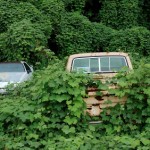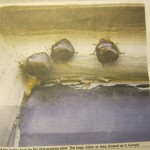I'm way afield on this post, but I just couldn't resist. I was reading The Wall Street Journal one recent morning and ran across an article with the intriguing title, "Bug Battle: An Invasive Plant Now Faces Its Own Attacker." The plant of course was kudzu. I thought it was widespread...somewhere in the South, and accidentally introduced, forty years or so ago, into the United States. I decided due diligence was needed here as in my other background research and looked for both the "bug" and the history of kudzu itself. I was hooked on the story within an hour.
It turns out that the introduction of kudzu into North America was more complex and multi-layered than I had ever suspected. The first mention of it in the United States dates back 135 years to the Centennial Exposition of 1876. Then, as one small part of a multi-national effort to celebrate the birth of our country, kudzu was shown as an ornamental vine at the Japanese Pavilion. In 1902 a botanist named David Fairchild, who had seen it used as pasturage in Japan, planted seedlings around his Washington, DC home. In the 1920s owners of a Florida nursery promoted its usage for forage and sold plants through mail-order.
Then came the Great Depression of the 1930s: the Civilian Conservation Corps gave jobs to hundreds of men planting kudzu for erosion control. In the 1940s Channing Cope, the farm editor of the Atlanta Journal-Constitution and one of the South's best-known and most influential radio broadcasters, started Kudzu Clubs to honor the so-called "miracle vine (July 4, 1949 edition of Time Magazine).
Kudzu spread, growing as much as a foot per day in the Southeast during Summer and sixty feet a year overall. In 1953, the US Department of Agriculture banned kudzu as a cultivated crop, but by then its aggressive growth had started taking over many thousands of acres. One prominent US Forest Service researcher tried various herbicides as control methods: over an 18-year period he didn't find a single agent that effectively controlled the vine; one actually promoted its growth.
A variety of uses for kudzu have been promoted by ingenious American scientists and merchants: an Agronomist at Tuskegee University found that angora goats could control the noxious plant on otherwise unusable land while simultaneously producing wool and milk. Others sell baskets made from kudzu, turn its blossoms into jelly and produce hay high in nutritive value. Potential drugs developed from kudzu are in the research pipeline, but not yet ready for human use in this country (though utilized for hundreds of years elsewhere).
But it now occupies over eight million acres of the Southeast and its native antagonist, a relative to stink bugs, wasn't found in the United States until 2009.
Now it's here, first discovered on the exterior of homes in northeast Georgia, but spreading rapidly to sixty Georgia counties, parts of the Carolinas and Tennesee. Megacopta cribaria, kudzu bugs, are small (4-6 mm long), olive-green and when crushed or disturbed, produce a "mildy offensive" odor. They also munch kudzu effectively with estimates of up to a third of the current infestation being eaten over the next decade. Unfortunately, perhaps inevitably, they like soybeans as well; perhaps the next step is to import the wasp that eats their eggs in Japan.
But then what...
Great tongue-in-cheek article on growing kudzu: 32nd Annual Blythewood Kudzu Festival Kudzu Growing Tips



